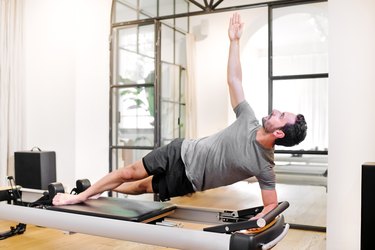
A look around any Pilates studio or class reveals a not-so-surprising truth: In general, more women gravitate toward Pilates than men. Perhaps one reason is that more men might prefer the weight room and don't understand the core-strengthening benefits of Pilates.
But it's time that changes. It's an effective workout that help can help everyone, regardless of gender, improve cardiovascular fitness, flexibility and core strength.
Video of the Day
Video of the Day
And lest we forget: Pilates was developed by a man. Joseph Pilates created the original Pilates system in the early 1900s, combining principles from dance and yoga and focusing on full-body movements controlled by the core, an area of the body also known as the "powerhouse."
A Note on Language
Here at LIVESTRONG.com, we carefully consider language surrounding sex and gender. We typically avoid language that implies a sex or gender binary in favor of neutral language, such as "assigned female at birth" (AFAB) and "assigned male at birth" (AMAB). We use "gender" when referring to a person's social identity; we use "sex" when referring to biological characteristics.
Most exercise research still categorizes people as men or women, so we're using those terms throughout this article.
More research is needed to more fully understand how biological differences may affect training in people taking hormones as part of gender-affirming care.
How Men Can Benefit From Pilates
While the benefits men get from Pilates are the same as they are for women, the main reason guys should sign up for a class is that the things the workout emphasizes are generally ones men put less focus on, says Stephanie Manning, certified Pilates teacher and owner of Pilates Barre Studio.
"Pilates increases flexibility and mobility in the shoulders, hips, spine and legs," she tells LIVESTRONG.com. Men tend to be a lot tighter in general than women due to increased muscle mass, and Pilates can help to release and stretch the tightness.
Pilates also evens out men's muscular strength. "Because men's strength is typically in their upper body, they can get really overdeveloped in their mid to upper back," she says. "Pilates retrains the way we use the body, so they can balance out their muscle structure and use their core more than their back."
And that added core strength can help prevent back pain. A January 2019 study in the Postgraduate Medical Journal found that Pilates-based exercise sessions two to three times a week were an effective therapeutic option to reduce chronic back pain. With about 80 percent of adults experiencing back pain at some point in their lives (according to the National Institutes of Health) that kind of protection is essential.
Pilates is also great for strengthening the pelvic floor. While women tend to pay more attention to this benefit, it's important for men, too, as they can experience similar bladder, bowel and sexual issues, according to the Mayo Clinic. A March 2015 study in Neurourology and Urodynamics of 85 men found Pilates to be as effective as conventional pelvic floor muscle exercise for improving incontinence.
5 Pilates Exercises for Men to Try
To get started, Manning recommends five Pilates movements that are great for anyone, but especially beneficial for men, as they focus on the areas that are often tight or underdeveloped in men.
1. The Roll Up
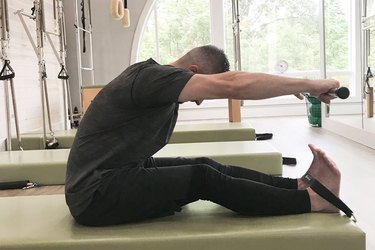
- Lie on your back with your legs extended and your arms overhead, palms up.
- Point your feet and press your lower back into the ground.
- Exhale to begin, then inhale and raise your arms up so your fingers point at the ceiling.
- Contract your abdominal muscles and gradually curl your spine off the mat, keeping your chin tucked into your chest.
- Lift slowly into a sitting position and reach toward your toes.
- Inhale and slowly unwind to the starting position while maintaining the C-curve in your spine.
- Repeat three to six times.
Tip
The classic Pilates roll up offers stretching and strengthening in one movement. It helps to open the back, hips, hamstrings and calves. All you need is a mat! Just be sure to engage your core and use its strength to flex your spine into an upright position.
2. Overhead

- Lie on your back with your arms holding the straps directly perpendicular to your body. (You can also do this exercise off the reformer with just a mat — more on this below.)
- Bring your legs up and over your head while rolling your hips off the mat.
- Keep the legs together and the hips extended so they are on the same diagonal.
- Use the backs of the upper arms for support and keep the chest open.
- Hold and, with control, return to start.
- Repeat four to six times.
Tip
Performing this move on a mat requires a lot of core strength and control. To make it easier, you have a few options: You can hold onto the legs of a chair or couch behind you, loop a resistance band around a fixed object behind you and hold onto the resistance band or place a yoga block behind you to hold onto.
Warning
Don't roll onto your neck! Keep your weight on your shoulders and upper back only or you'll risk straining your neck.
3. Baby Bird
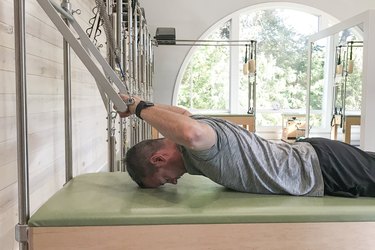
- Lie face down on the mat and stack your hands underneath your forehead.
- Press your pubic bone into the mat and lift your elbows.
- Press your hands into your head and keep your forehead connected to your hands as you lift.
- Slide your shoulders away from your ears as you lift.
- Hold for five seconds and lower down.
- Repeat four to six times.
4. Splits
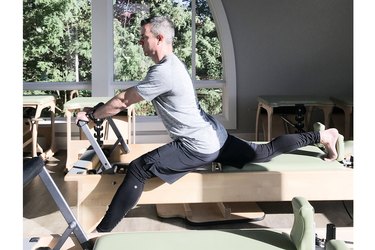
- Step onto the reformer facing away from the footbar and place the back foot on the footbar.
- Use your hands to stabilize yourself and lift the other foot into place on the headpiece. Lower the body.
- Step the front foot off the headpiece and the back foot off the footbar.
- Switch legs and repeat.
- You can also do this on a mat.
Tip
If you have tight hip flexors or quads, the splits, or thigh strength exercises, help open them up.
5. Chest Expansion
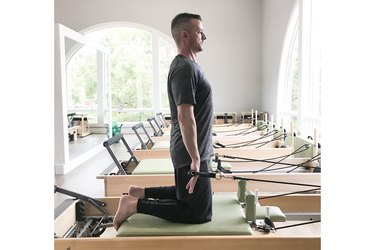
- Kneeling on the carriage of a Pilates reformer, hold onto the straps with a closed fist and palms facing the wall behind you.
- Pull the abdominals toward the spine and maintain a straight line from the neck to the knees.
- With straight arms slightly in front of you, and without moving anything else, press both arms straight back.
- Repeat four to six times.
Tip
This move focuses on control and core strength while opening the chest and balancing the shoulders. It engages the back of the shoulders, building strength while also opening up an area of the body that's often tight.
You can also do this move on a mat by looping a long resistance band with handles around a sturdy object in front of you. From a kneeling position, grab the handles and press both arms straight back.
- Mayo Clinic: "Kegel exercises for men: Understand the benefits"
- Neurourology and Urodynamics: "Is pilates as effective as conventional pelvic floor muscle exercises in the conservative treatment of post‐prostatectomy urinary incontinence? A randomised controlled trial:
- Postgraduate Medical Journal: "Application of Pilates-based exercises in the treatment of chronic non-specific low back pain: state of the art"
- National Institutes of Health: "Low back pain fact sheet"